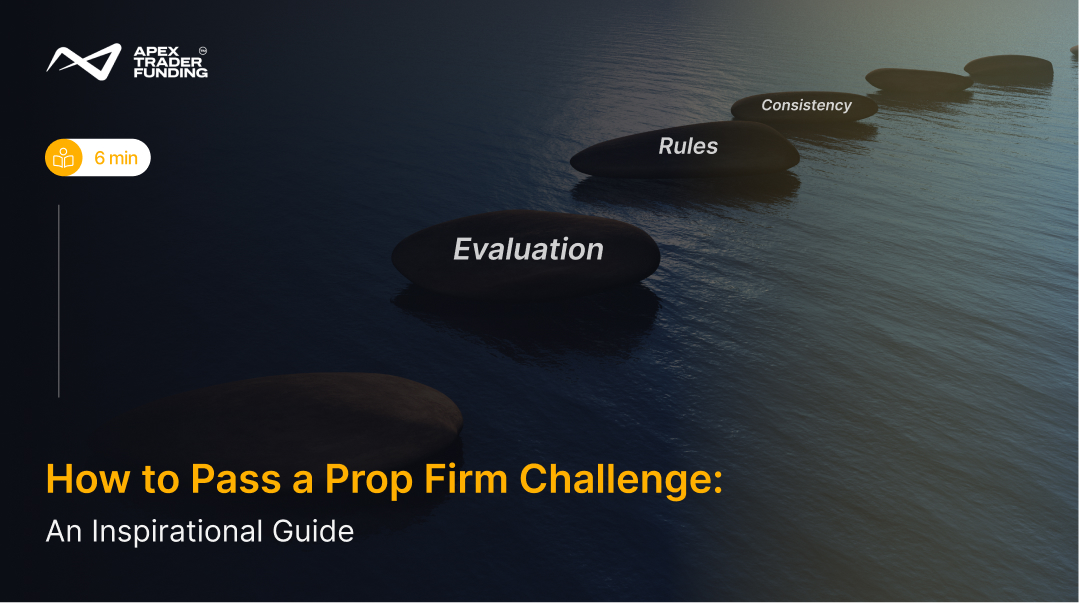
trading-education | 11-10-25
Passing a prop firm challenge represents more than a trading milestone — it’s proof of discipline, consistency, and the ability to perform under structure. These challenges offer traders the chance to manage large capital accounts without risking personal funds, but they also demand precision and patience.
How to Pass a Prop Firm Challenge?
Passing a prop firm challenge is less about perfect strategy and more about discipline, structure, and emotional control. These evaluations are built to test how well traders follow rules, manage risk, and stay consistent under pressure. Success begins with a defined trading plan — one that outlines your entries, exits, and risk limits — and the discipline to follow it precisely. Consistency, not large profits, is what proves your reliability as a trader.
Treat the challenge as a business exercise rather than a quick-money opportunity. Use trade journals and performance dashboards to track behavior, identify mistakes, and refine your execution. Passing isn’t about luck or flawless trades; it’s about showing you can manage capital responsibly, control emotions, and trade with the patience required for long-term success.
Comparison Table: Key Focus Areas for Passing a Prop Firm Challenge
1. Start with a Clear Trading Plan
No trader passes a challenge by accident. A well-defined trading plan is the foundation. Your plan should outline which markets you’ll trade, what strategies you’ll use, and how you’ll manage risk. Trading without a plan leaves you vulnerable to emotion-driven choices that often sabotage consistency.
- Define entry and exit criteria.
- Determine maximum risk per trade.
- Establish a daily or weekly trading routine.
A prop firm’s challenge isn’t just about profits—it’s about proving you can stick to a structured approach.
2. Respect the Risk Rules
One of the fastest ways to fail a challenge is by ignoring the rules. Firms design evaluations with drawdown limits, daily loss caps, and minimum trading days to filter out reckless behavior. Instead of seeing these as restrictions, treat them as training tools that reinforce discipline.
Key considerations include:
- Never risk more than 1–2% of your account per trade.
- Stop trading immediately if you hit your daily loss limit.
- Use stop-loss orders as non-negotiable safeguards.
Respecting these boundaries proves you can be trusted with real capital.
A prop firm challenge isn’t a test of luck—it’s a test of patience, discipline, and the ability to trade like a professional.
3. Focus on Consistency, Not Perfection
Many traders fail because they chase huge wins. Prop firms, however, are looking for steady performance. A series of modest, consistent trades often outshines one lucky home run.
- Small, controlled profits add up over time.
- Avoid overtrading to “make back” losses.
- Think marathon, not sprint.
Remember: passing is not about showing you can be perfect, but about proving you can be consistent under pressure.
4. Trade with Emotional Discipline
Challenges often test psychology more than strategy. Fear of missing out, revenge trading, and hesitation can all derail progress. Emotional discipline means staying calm when trades go against you and not overreacting to temporary setbacks.
Tips for emotional stability:
- Keep a trading journal to reflect on decisions.
- Step away from screens when stress builds.
- View losses as lessons, not failures.
The trader who controls emotions gains a competitive edge that no strategy alone can provide.
5. Use Tools to Stay Accountable
Modern trading platforms provide built-in features that help maintain structure during a challenge. Alerts, dashboards, and performance trackers help you stay on top of your progress and compliance with the firm’s rules.
Examples include:
- Risk calculators for position sizing.
- Trade journals for accountability.
- Performance dashboards to track rule compliance.
Technology, when used wisely, prevents small errors from turning into costly violations.
6. Balance Patience with Action
Passing a prop firm challenge is about pacing yourself. Overtrading can lead to mistakes, while undertrading can prevent you from meeting profit targets. Success requires balance: trading enough to progress, but not so much that you risk breaking rules.
- Wait for high-quality setups instead of forcing trades.
- Spread activity across the evaluation period.
- Avoid “end-of-challenge” desperation trades.
Patience combined with decisive execution is what separates successful candidates from those who fall short.
In trading, restraint is as valuable as execution—knowing when not to trade is often what keeps you in the game.
7. Learn from Every Evaluation
Even if you don’t pass on the first attempt, each challenge offers valuable lessons. Use the experience to refine your strategy, sharpen discipline, and strengthen your mindset. Many traders who eventually pass do so after analyzing where they went wrong the first time.
- Identify recurring mistakes.
- Adjust your strategy without abandoning proven methods.
- View setbacks as stepping stones rather than barriers.
Final Thoughts
A prop firm challenge is more than a path to funding — it’s a test of mindset and discipline. Success comes from composure, rule adherence, and the ability to adapt when conditions change. Every attempt, whether passed or failed, strengthens your understanding of structure and self-control.
Ready to prove your discipline and pass a prop firm challenge? Start with Apex Trader Funding. Begin today using the 25K WealthCharts account or the 25K Tradovate account and take your trading journey to the next level.
FAQs
It’s tough—only about 10–20% of traders pass on their first attempt. Most fail by breaking daily loss rules or over-leveraging. The key is to trade small, risk only 1–2% per trade, and focus on consistency. Success rates improve for traders who learn from prior attempts.
Prop firms can be good for beginners, but only if approached with discipline. They offer access to capital without risking personal savings, which lowers financial pressure. However, strict rules and evaluations mean beginners should first build skills with simulators and small trades before attempting a challenge.
The 2% rule is a common risk guideline in prop trading. It means you should never risk more than 2% of your account balance on a single trade. This protects traders from large losses, ensures longevity in the evaluation, and demonstrates discipline to the prop firm.
Related Blogs

trading-education | 22-08-25
What is a Funded Trading Account? - Detailed Guide
Trading has traditionally required large amounts of personal capital, leaving many aspiring traders locked out. A funded account changes that...
Read more
trading-education | 23-08-25
How Do Funded Trading Accounts Work?
Many new traders face the same challenge: limited capital and limited experience. Jumping into markets with personal savings often leads...
Read more
trading-education | 25-08-25
How to Get Funds for Trading? - 6 Practical Ways
Starting a trading journey often requires more than knowledge—it requires capital. Yet many aspiring traders face the same challenge: how...
Read more